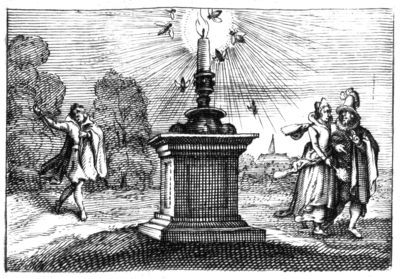Daniël Heinsius, Ambacht van Cupido, from: Nederduytsche poemata (1616)
Table of contents ↑Cosi de ben amar porto tormento. [32]


32.
Cosi de ben amar porto tormento.
32.
Cosi de ben amar porto tormento.
Den liefelicken schijn van haer twee schoone oogen
Die trecken my tot haer wanneer zy sich vertoogen,
Vertoogen ah! eylaes. ick schijne my te sijn
Verloren als ick ben van d'oorsaeck van mijn pijn.
By d'oorsaeck van mijn pijn woud' ick wel altijdt wesen,
Als ick ben by't verderf, soo schijn ick te genesen.
Ick vlieg' rontom het vier, ick blijf in eenen standt,
Tensy dat ick my self vind' ganschelick verbrandt.
Den liefelicken schijn van haer twee schoone oogen
Die trecken my tot haer wanneer zy sich vertoogen,
Vertoogen ah! eylaes. ick schijne my te sijn
Verloren als ick ben van d'oorsaeck van mijn pijn.
By d'oorsaeck van mijn pijn woud' ick wel altijdt wesen,
Als ick ben by't verderf, soo schijn ick te genesen.
Ick vlieg' rontom het vier, ick blijf in eenen standt,
Tensy dat ick my self vind' ganschelick verbrandt.
Sources and parallels
-
Parallel in the 1601 edition (motto and subscriptio the same; modified pictura (mirrored, less detailed in the background,
the single lover returns from the candle)): Cosi de ben amar porto tormento [8]
 (in: Daniël Heinsius, Quaeris quid sit Amor (c. 1601)
(in: Daniël Heinsius, Quaeris quid sit Amor (c. 1601) )
[Compare
)
[Compare ]
]
-
Parallel in the 1608 edition (motto and subscriptio are the same, modified pictura (mirrored, less detailed in the
background, the single lover returns from the candle)): Cosi de ben amar porto tormento [8]
 (in: Daniël Heinsius, Emblemata amatoria (1607/8)
(in: Daniël Heinsius, Emblemata amatoria (1607/8) )
[Compare
)
[Compare ]
]
-
Parallel for the pictura (mosquitos are attracted by a candle) and the meaning of the subscriptio.Brevis et damnosa voluptas [52]
 (in: Otto Vaenius, Amorum emblemata (1608)
(in: Otto Vaenius, Amorum emblemata (1608) )
[Compare
)
[Compare ]
]
-
Parallel for the main pictorial element (mosquitos flying towards a candle) and the meaning of the subscriptio. Brevis & damnosa voluptas [33]
 (in: Otto Vaenius, Emblemata aliquot selectiora amatoria (1618)
(in: Otto Vaenius, Emblemata aliquot selectiora amatoria (1618) )
[Compare
)
[Compare ]
]
References, across this site, to this page:
- Cosi de ben amar porto tormento [8]
 (in: Daniël Heinsius, Quaeris quid sit Amor (c. 1601)
(in: Daniël Heinsius, Quaeris quid sit Amor (c. 1601) )
)
- Cosi de ben amar porto tormento [8]
 (in: Daniël Heinsius, Emblemata amatoria (1607/8)
(in: Daniël Heinsius, Emblemata amatoria (1607/8) )
)
- Brevis et damnosa voluptas [52]
 (in: Otto Vaenius, Amorum emblemata (1608)
(in: Otto Vaenius, Amorum emblemata (1608) )
)
- Brevis & damnosa voluptas [33]
 (in: Otto Vaenius, Emblemata aliquot selectiora amatoria (1618)
(in: Otto Vaenius, Emblemata aliquot selectiora amatoria (1618) )
)
